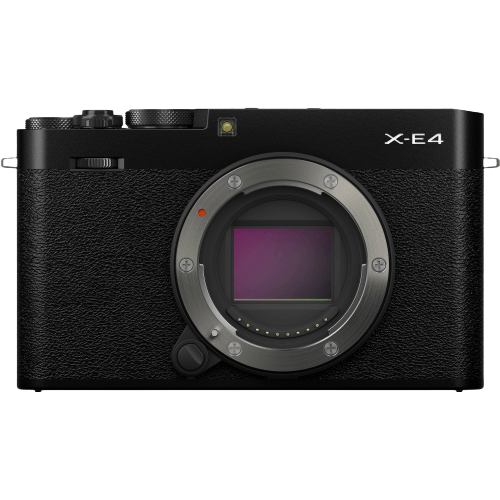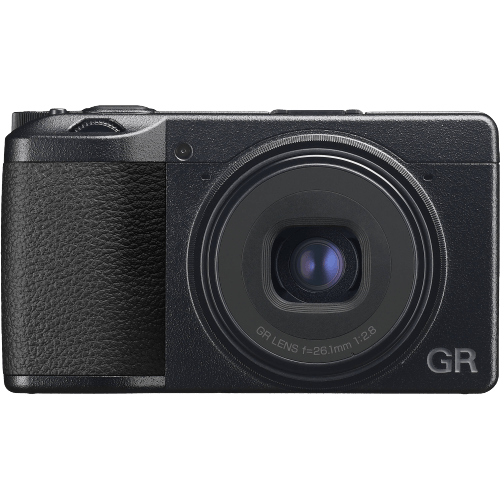Fujifilm X-E4 vs Ricoh GR IIIx Comparison
Fujifilm X-E4

Ricoh GR IIIx

The Fujifilm X-E4 and Ricoh GR IIIx both score 66/100 in our evaluation, making them equally competitive. These mirrorless and compact cameras were released in 2021, sharing similar announcement dates and launch prices of $849 and $999, respectively.
Both cameras share common specs, such as their release year, but the Fujifilm X-E4 stands out with its larger size (121 x 73 x 33mm) and heavier weight (364g). This could indicate a more robust design, catering to users who prefer a sturdier build.
On the other hand, the Ricoh GR IIIx is more compact and lightweight (109 x 62 x 35mm, 262g), making it a great choice for those seeking a portable camera for easy travel and everyday use.
Comparing these cameras, the Fujifilm X-E4 is better suited for users who value a solid build, while the Ricoh GR IIIx is perfect for those prioritizing portability. Both cameras offer unique benefits, catering to different user preferences.
Fujifilm X-E4 vs Ricoh GR IIIx Overview and Optics
The Ricoh GR IIIx narrowly wins in optics with a score of 68/100, compared to the Fujifilm X-E4’s 67/100. Both cameras share several common specifications. They both have CMOS sensors, APS-C sensor sizes, and similar megapixel counts, with the X-E4 having 26 megapixels and the GR IIIx having 24 megapixels.
The Ricoh GR IIIx has some advantages over the Fujifilm X-E4. It features image stabilization, which the X-E4 lacks. This allows for steadier shots and better performance in low light conditions. Additionally, the GR IIIx has a DXOMARK sensor score of 76, while the X-E4 does not have a DXOMARK score as Fujifilm cameras are not evaluated by the organization. The GR IIIx’s fixed lens mount may be seen as a disadvantage, but it ensures a compact and lightweight design.
On the other hand, the Fujifilm X-E4 has a faster shooting speed of 20 frames per second, compared to the GR IIIx’s 4 frames per second. This makes the X-E4 more suitable for capturing fast-paced action. The X-E4 also has a lens mount, allowing for a wider range of lenses and greater versatility. However, it lacks image stabilization, which may limit its performance in certain situations.
In comparing the optics of these two cameras, the Ricoh GR IIIx offers better image stabilization and a higher DXOMARK sensor score. The Fujifilm X-E4 excels in shooting speed and lens versatility. Both cameras have their unique strengths, and the choice between them will depend on the specific needs of the photographer.
Fujifilm X-E4 vs Ricoh GR IIIx Video Performance
The Fujifilm X-E4 outperforms the Ricoh GR IIIx in video capabilities, scoring 91/100 compared to the Ricoh’s 70/100. Both cameras share the feature of built-in time-lapse functionality, allowing users to create stunning time-lapse videos with ease.
The Fujifilm X-E4 excels in several key aspects. Firstly, it offers a maximum video resolution of 4K, with dimensions of 4096 x 2160, significantly surpassing the Ricoh GR IIIx’s Full HD resolution of 1920 x 1080. This higher resolution provides users with sharper and more detailed videos. Additionally, the Fujifilm X-E4 boasts a maximum video frame rate of 240fps, quadrupling the Ricoh GR IIIx’s 60fps. This higher frame rate allows for smooth slow-motion footage and reduces motion blur during fast action scenes.
On the other hand, the Ricoh GR IIIx has no specific advantages in its video capabilities compared to the Fujifilm X-E4. Its lower resolution and frame rate limit its potential for producing high-quality videos.
Taking these factors into consideration, the Fujifilm X-E4 clearly outshines the Ricoh GR IIIx in terms of video performance. The X-E4’s superior resolution and frame rate enable users to capture professional-grade videos with ease. Meanwhile, the Ricoh GR IIIx falls short in this area and is not the optimal choice for those prioritizing video capabilities. Therefore, those seeking a camera with excellent video performance should opt for the Fujifilm X-E4, while the Ricoh GR IIIx may be suitable for users with less demanding video requirements.
Fujifilm X-E4 vs Ricoh GR IIIx Features and Benefits
The Fujifilm X-E4 wins the feature comparison with a score of 72/100, while the Ricoh GR IIIx scores 70/100. Both cameras share some common specifications, such as a 3-inch touchscreen, WiFi, and Bluetooth capabilities. Furthermore, neither camera includes GPS functionality.
The Fujifilm X-E4 outperforms the Ricoh GR IIIx in terms of screen resolution and flip screen availability. The X-E4’s screen resolution is 1,620,000 dots, which is significantly higher than the 1,037,000 dots found on the GR IIIx. This difference results in a sharper and clearer display on the X-E4. Moreover, the X-E4 features a flip screen, which provides more flexibility and convenience for various shooting angles, unlike the GR IIIx.
The Ricoh GR IIIx does not excel in any specific feature when compared to the Fujifilm X-E4. Both cameras have similar specifications in most aspects, with the X-E4 having the edge in terms of screen quality and usability.
Considering these factors, the Fujifilm X-E4 offers better features for users, particularly in screen resolution and the addition of a flip screen. The Ricoh GR IIIx, while still a competent camera, does not surpass the X-E4 in any notable aspect. Users seeking a camera with higher screen resolution and a more flexible shooting experience should opt for the Fujifilm X-E4.
Fujifilm X-E4 vs Ricoh GR IIIx Storage and Battery
The Fujifilm X-E4 wins in storage and battery with a score of 35/100, while the Ricoh GR IIIx scores 27/100. Both cameras share common specifications, including one memory card slot, compatibility with SD/SDHC/SDXC (UHS-I) memory cards, and USB charging capability.
The X-E4 outperforms the GR IIIx in battery life, offering 380 shots per charge compared to the GR IIIx’s 200 shots. This difference makes the X-E4 more suitable for extended shooting sessions without needing frequent battery replacements or recharging.
The GR IIIx, however, has the advantage of internal storage in addition to its memory card slot. This feature provides extra storage capacity and a backup option for photographers who may run out of space on their memory cards.
In terms of storage and battery, the Fujifilm X-E4 offers better battery life, making it a more reliable choice for extended use. The Ricoh GR IIIx, with its internal storage, offers additional storage flexibility for photographers.
Fujifilm X-E4 vs Ricoh GR IIIx – Our Verdict
Are you still undecided about which camera is right for you? Have a look at these popular comparisons that feature the Fujifilm X-E4 or the Ricoh GR IIIx:
